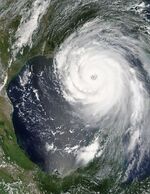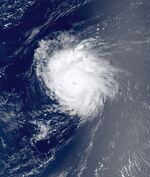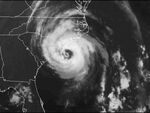The 1954 was an average season with 12 storms, 11 of them hurricanes, which was a record back then. The 1954 season was especially deadly, particularly in the US. Hurricanes Bertha, Cesar, Diana and Klaus killed 85 in the US and caused 505$ million in damages, most of it from Klaus. The season also affected the Caribbean. Hurricane Isidore killed 9 and caused 1$ million in damages in the Bahamas. Tropical Storm Lili was a late November storm that affected Panama. Only a few tropical systems affected the country. The season caused 91 deaths and 506$ million in damages.
- Last Season:1953 Atlantic hurricane season
- Next Season:1955 Atlantic hurricane season
Season summary[]
Timeline of tropical activity in the 1954 Atlantic hurricane season

Storms[]
Hurricane Arthur[]
| ||||
|---|---|---|---|---|
| ||||
| Duration | June 25 — June 28 | |||
| Intensity | 85 mph, 976 mb | |||
A cluster of thunderstorms became to show signs of development in late June in the Gulf of Mexico. The system became developed enough to become a tropical depression on June 25. The depression moved west towards the Texan coast and intensified into Tropical Storm Arthur. Arthur moved over warm water and became a hurricane on the 27. The next day, Arthur made landfall in Freeport, Texas as a strong Category 1 hurricane. It dissipated later on the 28. As Arthur made landfall in a sparsely populated area, it did not cause much damage but did kill 1 in Texas.
Hurricane Bertha[]
| ||||
|---|---|---|---|---|
| ||||
| Duration | August 19 — August 30 | |||
| Intensity | 115 mph, 965 mb | |||
Hurricane Bertha orogonated from a tropical wave that exited out of Africa in mid-August. The wave did not show signs of development until it was north of Hispaniola. The wave became a depression on August 19 and headed towards the Bahamas. The depression strengthened into a tropical storm and into a hurricane on the 21. Bertha paralleled the Cuban coast while making landfall in Key West, Florida as a weak Category 3 hurricane. Bertha slowed down until the 25, when it started to move north and made landfall near Pascagoula, Mississippi on the 26 as a weak Category 3 hurricane. Bertha quickly weakened into a tropical storm while moving northeastwards. On the 28, Bertha reemerged into the Atlantic from the South Carolina coast. And turned northeast once again, where it dissipated on the 30. Bertha caused 5$ million in damage and 7 deaths in the US.
Hurricane Cesar[]
| ||||
|---|---|---|---|---|
| ||||
| Duration | August 30 — September 10 | |||
| Intensity | 150 mph, 916 mb | |||
Like Bertha, Cesar also originated from a tropical wave from Africa. The wave became a depression in the open Atlantic on August 30. Seeking favorable development, the depression became a tropical storm the next day. Cesar moved northwestward, becoming a hurricane on September 1. Cesar peaked as a 150 mph Category 4 hurricane on the 3. Cesar started to weaken and brushed North Carolina as a weak Category 3 hurricane on the 7. Cesar recurved northeastwards gradually weakening until its dissipation in the open Atlantic on the 10. Cesar killed 40 and caused severe beach erosion in the Carolinas.
Hurricane Diana[]
| ||||
|---|---|---|---|---|
| ||||
| Duration | September 7 — September 12 | |||
| Intensity | 115 mph, 964 mb | |||
A low formed north of the Bahamas in early September. It became a depression on September 7. The depression quickly became a weak Category 3 hurricane later on the 8, making Diana one of the fastest intensifying hurricane on record. Diana moved towards Georgia and made landfall on the 8 as a weak Category 3 hurricane in Savannah, Georgia. Diana quickly weakened to a Category 1 on the 9. Diana reemerged the Atlantic on the 10 from the Virginia coast. Diana briefly restrengthened into a hurricane on the 11 before weakening again due to hugh wind shear and dissipated on the 12. Diana killed 26 in Georgia, the Carolinas and Virginia.
Hurricane Edward[]
| ||||
|---|---|---|---|---|
| ||||
| Duration | September 15 — September 19 | |||
| Intensity | 125 mph, 956 mb | |||
A cluster of thunderstorms formed over the warm waters of the Gulf of Mexico in mid September. The cluster strengthened into a depression on the 15 and into Tropical Storm Edward the next day. Edward moved towards Louisiana, making landfall as an 125 mph Category 3 hurricane in Buras, Lousiana on the 18 On the 19, Edward quickly dissipated over Alabama. Edward caused severe beach erosion in the Gulf Coast.
Hurricane Fran[]
| ||||
|---|---|---|---|---|
| ||||
| Duration | September 18 — September 22 | |||
| Intensity | 80 mph, 980 mb | |||
A tropical wave encountered favorable development in the warm waters of the Atlantic in mid September. On September 18, the wave became a depression, and moved north. Although at a high latitiude, the depression managed to became a tropical storm the next day. Fran reached hurricane status on the 19, and peaked as an 80 mph Category 1 hurricane later that day. On the 21, the sysyem turned northeast and weakened to a tropical storm. Fran dissipated on the 22. It did not affect land.
Hurricane Gustav[]
| ||||
|---|---|---|---|---|
| ||||
| Duration | September 22 — September 26 | |||
| Intensity | 80 mph, 980 mb | |||
A low began to form north of the Bahamas in mid September. On the 22, the low became a tropical depression and a tropical storm the next day. Gustav turned northeast, intensifying due to the wam waters of the Gulf Stream. Gustav peaked as an 80 mph hurricane on the 24 and started to weaken after that. Gustav dissipated on the 26 in the open Atlantic. Gustav did not cause any deaths or damages.
Hurricane Hortense[]
| ||||
|---|---|---|---|---|
| ||||
| Duration | September 23 — September 30 | |||
| Intensity | 80 mph, 976 mb | |||
The same low that spawned Hurricane Gustav spawned also Hurricane Hortense. On the 23, the low became a tropical depression that became a tropical storm later that day. Hortense moved north, almost parralel to Gustav, which is unusual. Hortense, like Gustav, intensified due to the Gulf Stream and peaked as an 80 mph Category 1 on the 24. Hortense slowly weakened and dissipated on September 30. Hortense did not affect land in any way.
Hurricane Isidore[]
| ||||
|---|---|---|---|---|
| ||||
| Duration | October 2 — October 12 | |||
| Intensity | 125 mph, 942 mb | |||
A disorganized system of showers affected the Caribbean in late September. Somewhere between Jamaica and Hispaniola, the system became a depression on October 2. The depression moved north and along the way became Tropical Storm Isidore. Isidore further strengthened and made landfall in Cuba as a weak Category 1 hurricane on the 3. Isidore started to affect the Bahamas, briefly weakening into a tropical storm. After moving over the Gulf Stream, Isidore intensified, peaking as a 125 mph Category 3 hurricane on the 5. Isidore started to weaken and became extratropical on the 12 off the Canadian coast. Isidore caused 1$ million in damage but killed 9 in the Bahamas.
Hurricane Josephine[]
| ||||
|---|---|---|---|---|
| ||||
| Duration | October 20 — October 24 | |||
| Intensity | 105 mph, 962 mb | |||
Late in October, a tropical wave exited out of Africa. The wave became a depression north of the Bahamas on October 20. The depression moved northwest, then northeast, and along the way became a tropical storm on the 22. Over the waters of the Gulf Stream, Josephine peaked as a 105 mph Category 2 on the 23, then subsequently weakened due to strong wind shear. Josephine dissipated on the 24 between the US and Bermuda.
Hurricane Klaus[]
| ||||
|---|---|---|---|---|
| ||||
| Duration | November 1 — November 9 | |||
| Intensity | 90 mph, 962 mb | |||
Klaus originated from a wave exiting the African coast in late October. On November 1, the wave became a depression near the southern tip of Florida. The depression crossed the Floridian peninsula and reemerged into the open Atlantic later that day. The depression strengthened into a tropical storm and Klaus parraleled the Eastern Seaboard. Klaus made landfall in North Carolina as an 90 mph Category 1 hurricane later that day. Klaus continued going up the coast until it dissipated above Canada on November 9. Klaus killed 22 in the US and caused 500$ million in damages.
Tropical Storm Lili[]
| ||||
|---|---|---|---|---|
| ||||
| Duration | November 22 — November 24 | |||
| Intensity | 65 mph, 992 mb | |||
A cluster of thunderstorms became a depression on November 22 in the southern Caribbean Sea. Going towards Central America, the depression became a tropical storm on the 23. Lili made landfall in Colon, Panama as a strong tropical storm and dissipated shortly thereafter. Lili caused no known damages or deaths. Lili was one of the very few tropical storm or hurricanes to make landfall in Panama.
Storm Names[]
These are the names that were used in the 1954 Atlantic hurricane season. The names that were mot retired were used again in 1960. Storms were named Arthur, Bertha, Cesar, Diana, Edward, Fran, Gustav, Hortense, Isidore, Josephine, Klaus and Lili for the first time in 1954. The names that were not used are marked in gray.
Arthur Hortense Omar (unused)
Bertha Isidore Paloma (unused)
Cesar Josephine Rene (unused)
Diana Klaus Sally (unused)
Edward Lili Teddy (unused)
Fran Marco (unused) Vicky (unused)
Gustav Nana (unused) Wilfred (unused)
Retirement: The names Cesar, Diana and Klaus were retired in 1954. They were replaced by Cristobal, Diane and Kyle for the 1960 season.












